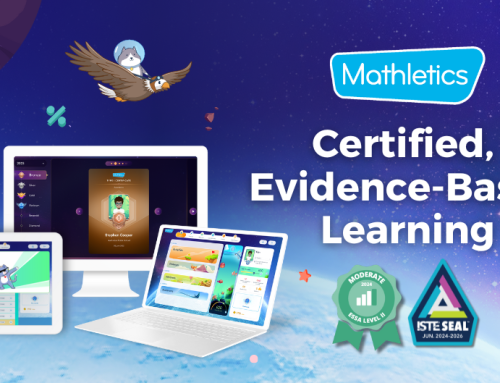Today’s mathematics lessons are different.
Processes and curriculums have changed, and so have the expectations of teachers and students. How has mathematics learning in the classroom changed over the past decade? We sat down with four educators to get their thoughts.
Here are their top five changes.
1. Shift from Teacher to Student-focused Learning
Back in the day: “Follow what I’m teaching.”
Now: “What are your learning goals and what do you need to do next to achieve them?”
15 years ago, a student might do a test and get a result without much feedback from a teacher.
Teachers would have been seen as the keeper of knowledge and students are vessels to be filled. One of the big changes in mathematics learning and teaching is a move away from this.
Teachers today play the role of a facilitator, guiding students to make discoveries about their learning. They help guide students to set their own goals, reflect on their learning, and be more aware of their strengths and weaknesses.
There is more feedback and collaboration between teachers and students. Students now take on a more active role in their process of learning, rather than being filled up with knowledge.
For teachers, this means having strong content knowledge, but also having a range of strategies at their disposal, so they can use it to meet the individual needs of diverse groups of students.
This may also be an uncomfortable process for some teachers, as it means letting go of ‘control’ and allowing students to have a productive struggle, that students will make mistakes and not get it right sometimes.
Thankfully, there are many resources out there to help teachers cater to different learning styles and needs. For example, online maths resource Mathletics helps you plan for differentiated learning.
2. Focus on Mathematical Process over Content
Back in the day: “Here’s a worksheet, fill in the answers.”
Now: “Show me how you solved that problem. table.”
Teaching has become highly personalised.
It’s not just about what students are learning, but how they’re learning. There is a greater focus on the process rather than the answer. Did students use communication in their answers?
The emphasis is less about students getting an answer, but more about if they articulated their steps clearly.
Teachers are required to guide students to explain how they solved a problem and discuss the different ways of solving the problem. This requires many hands-on teacher involvements, such as conversations, feedback, and having other students explain it in class.
Need a hand to find problem solving questions? There are 700 contextual real-world Problem-Solving and Reasoning questions in Mathletics to help students to demonstrate their thinking behind a solution through writing, drawing, or recording a voice memo. This lets you easily check if your students are communicating their solutions clearly.
 Because marking is no longer just running their eye down on answers, teachers need to look at every piece of students’ work and conversation. This has also impacted the way teachers teach.
Because marking is no longer just running their eye down on answers, teachers need to look at every piece of students’ work and conversation. This has also impacted the way teachers teach.
3. The Way Teachers Teach
Back in the day: “Plan a lesson, stick to it and follow it”
Now: “Can you adapt your lesson on the spot?”
In the past, teachers planned a lesson and followed through. They were measured on how good the lesson was and how well they stuck to it.
These days, it’s the opposite of that.
Teachers are expected to be flexible and adapt to what the students are doing at that moment. It’s not just about the instruction, but how students react to their instruction. This means the set-up of the actual content in what they’re asking students to do must be rethought.
“How can I teach students in a way that allows me to know what they’re thinking in their learning process?”
It’s also thinking of ways to provide students with different avenues of feedback, so teachers can use them to know what’s going on.
4. More Meaningful Integration of Technology
Back in the day: Technology was a one-way delivery
Now: Live and responsive two-way participation
Thanks to the emergence of video conferencing platforms, online learning in classrooms have evolved from a one-way delivered instruction with little teacher feedback, to an interactive learning space where students and teachers can collaborate in.
Technology has also vastly expanded the range of information and resources available to teachers and students. Online education programs, apps, games, or video tutorials – there’s a plethora of online learning resources for teachers and students.
5. Greater Parent Involvement
Then: “I can’t help them with their homework because that was not how I was taught”
Now: “Show me what you’re teaching in class and how I can help them at home.”
There’s been a shift to call parents or the wider family into a child’s learning.
This was accelerated in 2020 and 2021 when parents had to home-school or supervise their children as schools pivoted to a fully remote learning environment.
Today, there is a bigger three-way triangle between student, parent, and teacher. Schools are opening classrooms to home a lot more, with teachers encouraging parent involvement in their child’s education. education.
There have also been attitude shifts in parents, amidst changing education landscape.
Parents are more invested in their child’s development in school. They understand the importance of re-learning mathematics because the way they learned may not be aligned with what their kids are being taught today.
Having direct access to teachers through their email or the school’s online portal has also led to increased parent involvement, as they can now easily reach out to teachers for support or feedback.
Related read: The Importance of Parent-Teacher Communication
Looking Ahead: The Next Decade
What do we hope to see in mathematics learning in the next 10 years?
Firstly, a focus on a continuum of learning in skill development, such as critical thinking and life skills. We hope students will be able to persevere through a difficult algebra question or work collaboratively in a team to solve a problem.
Secondly, to continue the path of students as problem-solvers and teachers as facilitators, so that students can experience more learning around how to learn, instead of what to learn.
Just as the mathematical landscape continues to evolve, so do teachers.
Teachers must be adaptable, life-long learners who regularly reflect on their teaching practice. It is a challenging, yet an exciting time with technology creating new opportunities for learning and connecting.








